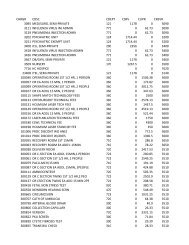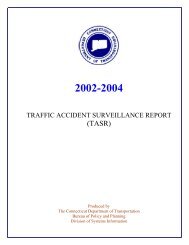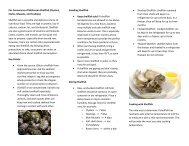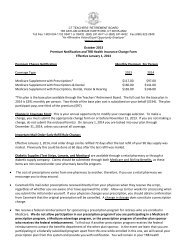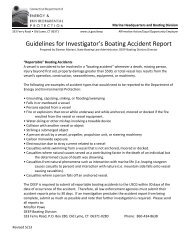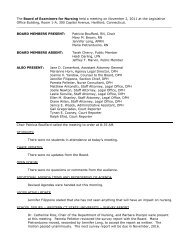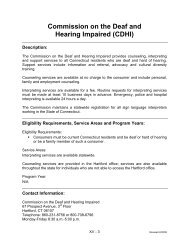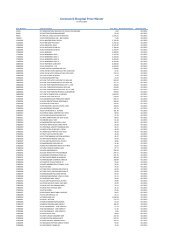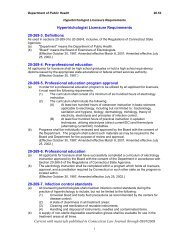Public Act 490 Guide - CT.gov
Public Act 490 Guide - CT.gov
Public Act 490 Guide - CT.gov
You also want an ePaper? Increase the reach of your titles
YUMPU automatically turns print PDFs into web optimized ePapers that Google loves.
This is why the PA <strong>490</strong> classification is so important. It<br />
protects land against higher-level property taxes that could<br />
otherwise induce landowners to sell their land. This is<br />
what the intent and purpose of the act attempt to control.<br />
The PA <strong>490</strong> program is Connecticut’s principal means to<br />
ensuring the availability of farmland for production.<br />
It is critical that owners of PA <strong>490</strong> farmland<br />
respond in a timely manner to any mail from the<br />
assessor's office regarding their farming operation.<br />
Open communication between landowners and the<br />
assessor is essential to maintaining the farmland<br />
classification and for avoiding problems in the future.<br />
THE ROLE OF ASSESSOR, LANDOWNER<br />
AND STATE AGENCIES IN FARMLAND<br />
CLASSIFICATION<br />
Role of Assessor: CGS Section 12-107(c) states that<br />
the local assessor is charged with determining what will or<br />
will not qualify as PA <strong>490</strong> farmland. This determination<br />
should be done in a fair and equitable manner within the<br />
statutory requirements giving due consideration to the<br />
intent and purpose of the law. The assessor should be<br />
certain that an application is completed in full and signed<br />
and dated by the landowner(s).<br />
It is advisable for assessors to communicate with<br />
other public officials within their town when undertaking<br />
any taxation issues such as questionnaires,<br />
changes in format, review of previous assessor's<br />
work, etc. Due to the potential increase in inquiries<br />
from taxpayers, all town officials should be informed<br />
especially during times of revaluation.<br />
Role of the Farmland Owner: The primary role of the<br />
farmland owner is to keep the land in agricultural use in<br />
order to maintain the PA <strong>490</strong> classification. Applications for<br />
new PA <strong>490</strong> farmland should be completed and filed within<br />
the required filing periods set forth in CGS Section 12-<br />
107c(a). Form M-29 should be completed in full and signed<br />
and dated by the landowner(s). It may be helpful to provide<br />
supporting documentation such as aerial photos or<br />
maps of the farming operation and to clarify any questions<br />
the assessor may have regarding information on the<br />
application. Farmers should be general enough in their<br />
description of their farming operation to include all activities<br />
in which they are engaged, recognizing their initial statement<br />
needs to remain accurate for as many years in the<br />
future as possible. Applications that are not filed within<br />
the prescribed time frame or are incomplete will not be<br />
accepted for PA <strong>490</strong> farmland classification. The landowner<br />
should request a copy of the fully-signed and<br />
dated application from the assessor at the time of filing.<br />
It is very important that landowners keep signed and<br />
dated copies of any documents that are submitted to<br />
the assessor. The signed and dated application is critical<br />
should a classification ever be questioned or an issue of<br />
the conveyance recapture tax arise. Landowners should<br />
not rely on the town to keep records for them.<br />
Role of the State Agencies: The state has several roles.<br />
CGS Section 12-107c(b) of the statutes says that the application<br />
for classification of land as farmland shall be made<br />
upon a form prescribed by the Commissioner of Agriculture<br />
(Form M-29), which is available from the assessor’s office.<br />
CGS Section 12-2b of the state statutes states: The<br />
Secretary of the Office of Policy and Management shall:<br />
(1) In consultation with the Connecticut Department of Agriculture<br />
develop schedules of unit prices for property classified<br />
under CGS Sections 12-107a to 12-107e inclusive, update such<br />
schedules by October 1, 1990, and every five years thereafter,<br />
and make such data, studies and schedules available to<br />
municipalities and the public. These are the Recommended<br />
Use Values shown in Appendix D. They are sent to all<br />
assessors in the state.<br />
CGS Section 22-4c(4) addresses the powers of Commissioner<br />
of Agriculture: provide an advisory opinion, upon<br />
request of any municipality, state agency, tax assessor or any<br />
landowner as to what constitutes agriculture or farming<br />
pursuant to subsection (q) of section 1-1, or regarding classification<br />
of farmland or open space land pursuant to sections<br />
12-107b to 12-107f, inclusive.<br />
Although the local assessor actually approves the<br />
classification, the state Department of Agriculture may be<br />
involved in determination of status. Other sources of information<br />
or assistance are available from the Connecticut<br />
Farm Bureau Association, the University of Connecticut<br />
College of Agriculture and Resources, and local United<br />
States Department of Agriculture offices.<br />
DETERMINATION OF PA <strong>490</strong> FARMLAND<br />
The first thing that landowners making an application<br />
for PA <strong>490</strong> farmland classification should understand is that<br />
the town assessor has the authority to determine what<br />
may or may not qualify for such designation in accordance<br />
with state statutes and the intent of the act. The determination<br />
that land is PA <strong>490</strong> farmland or agriculture is not<br />
always obvious. Today, it is not unusual for a farm to be<br />
rather small in size, or for a farmer to be in the business on a<br />
part-time basis with outside supporting sources of income.<br />
Often non-farmer owned parcels are leased to farmers, and<br />
larger tracts of farmland often have absentee landowners.<br />
Many farms are fragmented into numerous parcels, and<br />
often existing farms are not utilized as they historically<br />
have been due to numerous factors.<br />
SE<strong>CT</strong>ION 5: FARMLAND CLASSIFICATION<br />
Connecticut Farm Bureau Association • http://www.cfba.org/pa<strong>490</strong>guide.htm • <strong>Public</strong> <strong>Act</strong> <strong>490</strong>: A Practical <strong>Guide</strong> and Overview<br />
9




